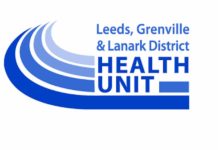Medical Officer of Health, Leeds, Grenville and Lanark District Health Unit in regards to Rise in COVID Cases
The COVID-19 virus is spread by close contact with someone who has COVID-19. The COVID-19 virus is in the moisture of the infected person that comes from the nose and mouth during breathing, coughing or sneezing. The moisture can’t stay in the air very long before it falls to the ground.
Therefore, keeping 2 metres way from others is important to reduce the spread of the COVID-19 virus. A well-fitted two- or three-ply mask can trap the moisture for the mouth which also reduces the spread of the virus.
Cleaning common surfaces is also important as the virus can survive on some surfaces for a while. Staying home when you have possible symptoms of COVID-19 (including headache, fever, sore throat, congestion, diarrhea, loss of taste and smell) and going for a test are also important to protect those around you.
When someone tests positive for COVID-19, an assessment is done by public health to identify who may have had close contact, within 2 metres, with the individual while they were infectious. Individuals are considered infectious from two days before symptoms develop and while they are experiencing symptoms. These people who have had close contact, within 2 metres, with the individual who was infectious are called high-risk contacts.
All high-risk contacts are then contacted and asked to isolate at home for 14 days after their last contact with the individual during their infectious period. They also are asked to go for testing.
We have had questions from people who want to know if they have to isolate when they have had contact with a high-risk contact before that high-risk contact started isolating.
If you live in the same house as the high-risk contact, you can only go out for essential reasons (work, school, groceries, pharmacy, health care appointments) because you have possible on-going contact with the high-risk person. By contrast, if you have had close contact with someone considered high-risk (who doesn’t have symptoms), before the person went into isolation, then you do not need to isolate.







